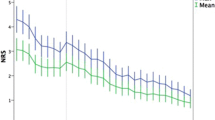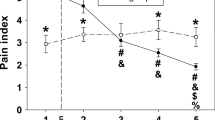Abstract
Purpose
The number of total hip and knee arthroplasties (THA and TKA) is steadily increasing. Many factors that influence pain have been reported, but little is known about the correlation between the time of day and the duration of surgery and postoperative pain. On one hand, surgical interventions are performed faster due to economic pressure; on the other hand, obtaining sound surgical skills and a thorough education are most important for young surgeons, particularly at university hospitals. Amidst these different interests, it is the patient who should be the focus of all medical efforts. Therefore, our study investigated the effects of the time of day and the duration of total knee and hip arthroplasty on postoperative pain perception and patient satisfaction.
Methods
623 patients were analyzed 24 h after primary total knee or hip arthroplasty regarding pain, patient satisfaction, and side effects by means of the questionnaires of the German-wide project Quality Improvement in Postoperative Pain Management (QUIPS).
Results
The time of day and the duration of knee or hip arthroplasty were not correlated with maximum, minimum, and activity-related pain and patient satisfaction rated on a numeric rating scale (NRS).
Conclusions
This study is the first to show that neither the time of day nor the duration of surgery has any influence on patient satisfaction and postoperative pain 24 h after total knee or hip arthroplasty; regarding these aspects, young orthopaedic surgeons may be trained in the operating theatre without time pressure.




Similar content being viewed by others
References
Learmonth ID, Young C, Rorabeck C (2007) The operation of the century: total hip replacement. Lancet 370(9597):1508–1519
Kurtz S, Ong K, Lau E, Mowat F, Halpern M (2007) Projections of primary and revision hip and knee arthroplasty in the united states from 2005 to 2030. J Bone Joint Surg Am 89(4):780–785
Benditz A, Drescher J, Greimel F, Zeman F, Grifka J, Meißner W, Völlner F (2016) Implementing a benchmarking and feedback concept decreases postoperative pain after total knee arthroplasty: a prospective study including 256 patients. Sci Rep 6:38218
Benditz A, Völlner F, Baier C, Götz J, Grifka J, Keshmiri A (2015) Course of pain after operative orthopedic interventions: characterization exemplified by total knee arthroplasty. Schmerz 30(2):181–186
Gerbershagen HJ, Pogatzki-Zahn E, Aduckathil S, Peelen LM, Kappen TH, van Wijck AJ et al (2014) Procedure-specific risk factor analysis for the development of severe postoperative pain. Anesthesiology 120(5):1237–1245
Benditz A, Greimel F, Auer P, Zeman F, Göttermann A, Grifka J et al (2016) Can consistent benchmarking within a standardized pain management concept decrease postoperative pain after total hip arthroplasty? A prospective cohort study including 367 patients. J Pain Res 9:1205–1213
Weber P, Paulus AC, Hallmen D, Steinbrück A, Schmidutz F, Jansson V (2017) Does the certification according to EndoCert lead to a better quality of treatment? Orthopade 46(1):78–84
Fehring TK, Odum SM, Troyer JL, Iorio R, Kurtz SM, Lau EC (2010) Joint replacement access in 2016: a supply side crisis. J Arthroplasty 25(8):1175–1181
Haughom BD, Schairer WW, Hellman MD, Yi PH, Levine BR (2014) Resident involvement does not influence complication after total hip arthroplasty: an analysis of 13,109 cases. J Arthroplasty 29(10):1919–1924
Reidy MJ, Faulkner A, Shitole B, Clift B (2016) Do trainee surgeons have an adverse effect on the outcome after total hip arthroplasty?: a ten-year review. Bone Joint J 98-B(3):301–306
Hedlundh U, Ahnfelt L, Hybbinette CH, Weckstrom J, Fredin H (1996) Surgical experience related to dislocations after total hip arthroplasty. J Bone Joint Surg Br 78(2):206–209
Schoenfeld AJ, Serrano JA, Waterman BR, Bader JO, Belmont PJ (2013) The impact of resident involvement on post-operative morbidity and mortality following orthopaedic procedures: a study of 43,343 cases. Arch Orthop Trauma Surg 133(11):1483–1491
Sendtner E, Borowiak K, Schuster T, Woerner M, Grifka J, Renkawitz T (2011) Tackling the learning curve: comparison between the anterior, minimally invasive (micro-hip®) and the lateral, transgluteal (bauer) approach for primary total hip replacement. Arch Orthop Trauma Surg 131(5):597–602
Chughtai M, Jauregui JJ, Mistry JB, Elmallah RK, Diedrich AM, Bonutti PM et al (2016) What influences how patients rate their hospital after total knee arthroplasty? Surg Technol Int 28:261–265
Mistry JB, Chughtai M, Elmallah RK, Le S, Bonutti PM, Delanois RE, Mont MA (2016) What influences how patients rate their hospital after total hip arthroplasty? J Arthroplasty 31(11):2422–2425
Kopkow C, Schmitt J, Haase E, Lange T, Günther KP, Lützner J (2015) Objectifying results in total knee arthroplasty: is “patient satisfaction” adequate. Orthopade 4:261-4–266-8
Kesterke N, Egeter J, Erhardt JB, Jost B, Giesinger K (2015) Patient-reported outcome assessment after total joint replacement: Comparison of questionnaire completion times on paper and tablet computer. Arch Orthop Trauma Surg 7:935–941
Valera M, Ibañez N, Sancho R, Tey M (2016) Reliability of tönnis classification in early hip arthritis: a useless reference for hippreserving surgery. Arch Orthop Trauma Surg 1:27–33
Baumann F, Ernstberger T, Loibl M, Zeman F, Nerlich M, Tibesku C (2016) Validation of the german forgotten joint score (G-FJS) according to the COSMIN checklist: Does a reduction in joint awareness indicate clinical improvement after arthroplasty of the knee? Arch Orthop Trauma Surg 2:257–264
Rothaug J, Weiss T, Meissner W (2012) External validity of pain-linked functional interference: are we measuring what we want to measure? Schmerz 26(4):396–401
Bozic KJ, Beringer D (2007) Economic considerations in minimally invasive total joint arthroplasty. Clin Orthop Relat Res 463:20–25
Lavernia CJ, Sierra RJ, Hernandez RA (2000) The cost of teaching total knee arthroplasty surgery to orthopaedic surgery residents. Clin Orthop Relat Res 380:99–107
Woolson ST, Kang MN (2007) A comparison of the results of total hip and knee arthroplasty performed on a teaching service or a private practice service. J Bone Joint Surg Am 89(3):601–607
Weber M, Völlner F, Benditz A, Schwarz T, Wörner M, Craiovan B et al (2016) Total knee arthroplasty in the elderly. Orthopade 46:34–39
Kehlet H, Wilkinson RC, Fischer HB, Camu F (2007) PROSPECT: evidence-based, procedure-specific postoperative pain management. Best Pract Res Clin Anaesthesiol 21(1):149–159
Myles PS, Williams DL, Hendrata M, Anderson H, Weeks AM (2000) Patient satisfaction after anaesthesia and surgery: results of a prospective survey of 10,811 patients. Br J Anaesth 84(1):6–10
Acknowledgements
We thank Monika Schöll for the linguistic review of our manuscript and Melanie Schmidt for her support collecting the data.
Author information
Authors and Affiliations
Contributions
AB, GM, FZ, JG, FK, MW, FG, and AK made substantial contributions to the conception and design, analysis, and interpretation of data. AB, FG, GM, and AK made substantial contributions to the acquisition of data. All authors were involved in drafting the manuscript and revising it critically for important intellectual content. In addition, all authors gave final approval of the version to be published. All authors agreed to be accountable for all aspects of the work in ensuring that questions related to the accuracy or integrity of any part of the work are appropriately investigated and resolved.
Corresponding author
Ethics declarations
Conflict of interest
All authors declare that they have no conflict of interest.
Ethical approval
The project was approved by the Ethics Committee and the Data Security Board of the Jena University Hospital, Jena, Germany, as well as by the Ethics Committee of the University of Regensburg. The study is registered in the German Register of Clinical Studies (DRKS) under the Number DRKS00006153 (WHO Register). All procedures conducted in studies involving human participants were in accordance with the ethical standards of the institutional and/or national research committee and with the Helsinki declaration of 1964 and its later amendments or comparable ethical standards.
Rights and permissions
About this article
Cite this article
Benditz, A., Maderbacher, G., Zeman, F. et al. Postoperative pain and patient satisfaction are not influenced by daytime and duration of knee and hip arthroplasty: a prospective cohort study. Arch Orthop Trauma Surg 137, 1343–1348 (2017). https://doi.org/10.1007/s00402-017-2769-9
Received:
Published:
Issue Date:
DOI: https://doi.org/10.1007/s00402-017-2769-9




